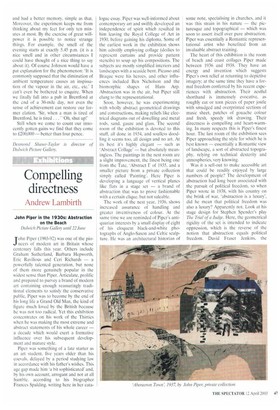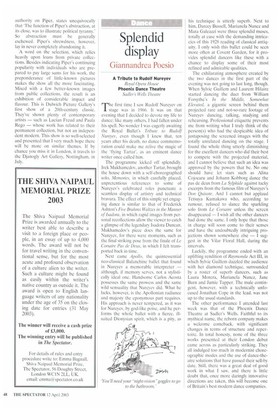Compelling directness
Andrew Lambirth
John Piper in the 1930s: Abstraction on the Beach
Dulwich Picture Gallery until 22 Jutte
John Piper (1903-92) was one of the pioneers of modern art in Britain whose centenary falls this year. Others include Graham Sutherland, Barbara Hepworth, Eric Ravilious and Ceri Richards — a powerfully talented generation, but none of them more genuinely popular in the widest sense than Piper. Articulate, prolific and prepared to purvey a brand of modern art containing enough reassuringly traditional elements to satisfy the conservative public, Piper was to become by the end of his long life a Grand Old Man, the kind of figure much loved by the British because he was not too radical. Yet this exhibition concentrates on his work of the Thirties when he was making the most extreme and abstract statements of his whole career — a decade which would exert a formative influence over his subsequent development and mature style.
Piper was something of a late starter as an art student, five years older than his coevals, delayed by a period studying law in accordance with his father's wishes. This age gap made him 'a bit sophisticated' and, by his own account, arrogant and not at all humble, according to his biographer Frances Spalding, writing here in her cata
logue essay. Piper was well-informed about contemporary art and swiftly developed an independence of spirit which resulted in him leaving the Royal College of Art in 1930, before gaining his diploma. Some of the earliest work in the exhibition shows him adroitly employing collage (doilies to represent curtains and provide pattern stencils) to soup up his compositions. The subjects are mostly simplified interiors and landscapes with a seaside bent. Picasso and Braque were his heroes, and other influences included Ben Nicholson and the biomorphic shapes of Hans Arp. Abstraction was in the air, but Piper still clung to the representational.
Soon. however, he was experimenting with wholly abstract geometrical drawings and constructions, making reliefs like electrical diagrams out of dowelling and metal rods, sand, gauze and glass. The second room of the exhibition is devoted to this stuff, all done in 1934, and soulless doodling it seems too, all design and no art. At its best it's highly elegant — such as 'Abstract Collage' — but absolutely meaningless. The paintings in the next room are a slight improvement, the finest being one from the Tate, 'Abstract I' of 1935, and a smaller picture from a private collection simply called 'Painting'. Here Piper is developing a language of vertical planes like flats in a stage set — a brand of abstraction that was to prove fashionable with a certain clique, but not saleable.
The work of the next year, 1936, shows increased assurance of handling and greater inventiveness of colour. At the same time we are reminded of Piper's antiquarian interests by a small display of eight of his eloquent black-and-white photographs of Anglo-Saxon and Celtic sculpture. He was an architectural historian of some note, specialising in churches, and it was this strain in his nature — the picturesque and topographical — which was soon to assert itself over pure abstraction. Piper was essentially a Romantic representational artist who benefited from an invaluable abstract training.
The heart of this exhibition is the room of beach and coast collages Piper made between 1936 and 1938. They have an energy and invention which suggests Piper's own relief at returning to depictive imagery; at the same time they have a formal freedom conferred by his recent experiences with abstraction. Their zestful shorthand is immensely evocative, as roughly cut or torn pieces of paper jostle with smudged and overprinted sections of music sheet, patches of gouache colour and fresh, speedy ink drawing. Their directness is compelling and heart-warming. In many respects this is Piper's finest hour. The last room of the exhibition sees Piper approaching the style for which he is best known — essentially a Romantic view of landscape, a sort of abstracted topography, relying on technical dexterity and atmospherics, very knowing.
Was it a sell-out to make accessible art that could be readily enjoyed by large numbers of people? The development of abstraction had long been associated with the pursuit of political freedom, so when Piper wrote in 1938, with his country on the brink of war, 'abstraction is a luxury', did he mean that political freedom was also a luxury? Apparently not. Look at his stage design for Stephen Spender's play The Trial of a Judge. Here, the geometrical rigidity of the set is intended to indicate oppression, which is the reverse of the notion that abstraction equals political freedom. David Fraser Jenkins, the authority on Piper, states unequivocally that 'The function of Piper's abstraction, at its close, was to illustrate political tyranny.' So abstraction must be generally eschewed. Piper's shrewdness, however, lay in never completely abandoning it.
A word on the selection, which relies heavily upon loans from private collections. Besides indicating Piper's continuing popularity with individuals who are prepared to pay large sums for his work, the preponderance of little-known pictures makes the show all the more fascinating. Mixed with a few better-known images from public collections, the result is an exhibition of considerable impact and flavour. This is Dulwich Picture Gallery's first show of a 20th-century classic. They've shown plenty of contemporary artists — such as Lucian Freud and Paula Rego — whose work has related to their permanent collection, but not an independent modern. This show is so well-selected and presented that I very much hope there will be more on similar themes. If by chance you miss it in London, it travels to the Djanogly Art Gallery, Nottingham, in July.



































































 Previous page
Previous page